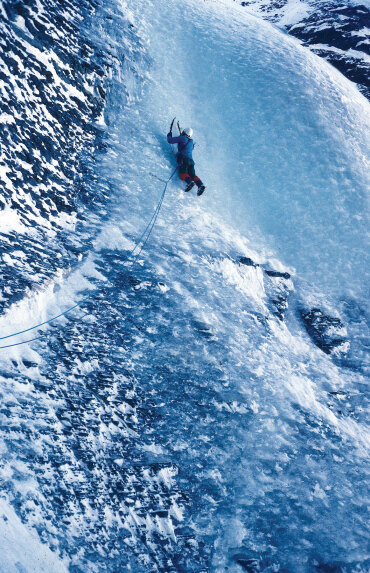ALPINIST BARRY BLANCHARD ON “THE CALLING”
By Meghan J. Ward
In this interview with Canadian alpinist, Barry Blanchard, we get beyond the pages of his first book, The Calling: A Life Rocked By Mountains, and dig into his writing process, favourite climbs, tactics for enduring a sufferfest, and how fatherhood has affected his climbing.
MW/ Did you initiate this book or did the publisher?
BB/ I initiated it. I probably made the first attempt at beginning the book 25 years ago. It has been a long process. It wasn’t until the Banff Mountain & Wilderness Writing Program in 2009 that I really got the first chapters of what is now called The Calling down on paper. I spent the money they gave me as an advance, so then I had to write the book!
It’s a battle of trying to find time to write. It’s tough being a father of two, who has a full time job as a mountain guide.
MW/ How did you choose the stories you featured in The Calling?
BB/ The 1990s attempt of the book was called “Winter Count”. [A winter count is a Native American tradition wherein significant events of each year are captured in pictures, alongside an extensive oral history.] I can winter count my life by the most significant climb of each year. For that attempt of the book, I picked the most significant ascent of each year. Then, in 2009, I realized that some of my chapters became about the people on the rope with me, which is more important than the mountains I was climbing. I also tried to sift out pieces from my childhood that shaped me as a mountaineer.
Again, it wasn’t easy choosing which stories to include. The first chapter I submitted on Nanga Parbat was 30,000 words long.
People want to read a chapter and go to bed, said my editor. You’re gonna keep people up for three days.
MW/ What process do you go through to get back into the mindset you were in when climbing in order to write those passages for the book?
BB/ I think it comes with a lot of time up there – thousands of days spent in that environment. Some of the pitches are such intense experiences that they are branded into your memory. I can see some of the rock holds or some of the ice pitches. But then, I’ve just spent so much time up there that it’s kind of like a room that I can step into – a very rich, amazingly detailed and varied room. I can think of 30 different representations for the medium of ice. Then there’s the snow, the rock and what the weather is doing.
MW/ Out of all the mountain ranges of the world, what ultimately draws you to the Rockies?
BB/ I think I am drawn to them because I was born on the Bow River and the Bow River is one of the central outflows of the Rockies. It was something I could see even as a poor kid growing up in Calgary. We lived on the West side of the city, so I could see the mountains growing up.
My education as an alpinist mostly happened here in the Rockies, as well as my breakthroughs in techniques in rock and snow. The big faces where I put up new routes are here in the Rockies.
Another charm of the range is its remoteness. There is a wildness to the Rockies. There is something to be said for carrying 50-pound packs and walking for a day to get to the base of your climb.
MW/ Out of all your first ascents in the Rockies, which one are you most proud of?
BB/ The one I’m known the best for – the North Pillar of the North Twin in 1985 – and that’s largely because it was the last major climb I did with David Cheesmond. David died on Mt. Logan two years after, and that was the end of a 5-year friendship that was incredibly intense. It was far, far too short.
MW/ You clearly knew how to endure suffering in your first few decades of climbing. What got you through the toughest of times?
BB/ One of the great things about alpinism is that it brings young men to prayer. I don’t want to make suggestions of what or whom people pray to, but praying is amazingly important for human beings. The act of prayer – to ask for some kindness from the universe, for some consideration – it really helps.
It is part of accepting what is going on and the real threats that you are facing. The environment that you’re in is so much bigger than you. The universe is basically calling the shots, and you’re surrendering to that fact. You’re asking for some help.
MW/ You briefly mention your daughters in this book. How has fatherhood affected your climbing?
BB/ Immediately, on the birth of my first daughter, it definitely changed the way I look at risk. For an alpinist, every time you move a hand or foot on the mountain you’re making a decision about risk. I would see my daughter’s face every time I made a decision. It definitely gave me new responsibility I didn’t have before.
A huge change is that you’ve got to take one-third of your time and put it towards being a father. I still climb professionally – quite a lot. That’s one of the other things that being a father has done for me: I have to work to provide for my daughters.
I was still trying fairly ambitious alpine routes when my daughters were younger. But I was 45 when I had my first daughter, so my athletic ability will never be the same as I was when I was 35. I don’t have as much time to train anymore, and there are a lot of things that go downhill with age.
MW/ The Calling ends around 25 years in the past. Was it the original intent to focus on your first few decades of climbing? Will a “Part 2” come eventually?
BB/ I thought the book would end relatively present day and I was trying to decide which climbing adventure to end the book on. I just seemed to have been cursed with a long memory. When I sat down to write the book, contractually the book was 120,000 words and I submitted 140,000. I realized I was never going to get to the present day. It’s going to end in 1988 – I just have too much to say. I’m not yet working on a Part 2. I really want to, though. Should I call it “The Answer”?
Meghan J. Ward is a writer, editor, digital content specialist and all-around storyteller based in Banff, Canada. Meghan loves any sport that takes her up a mountain or into the backcountry, and also enjoys travel and photography.



